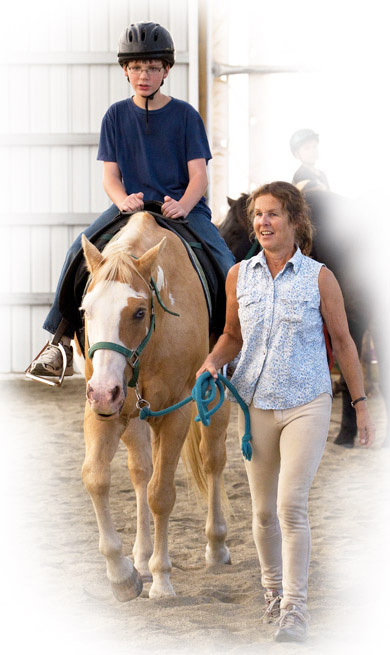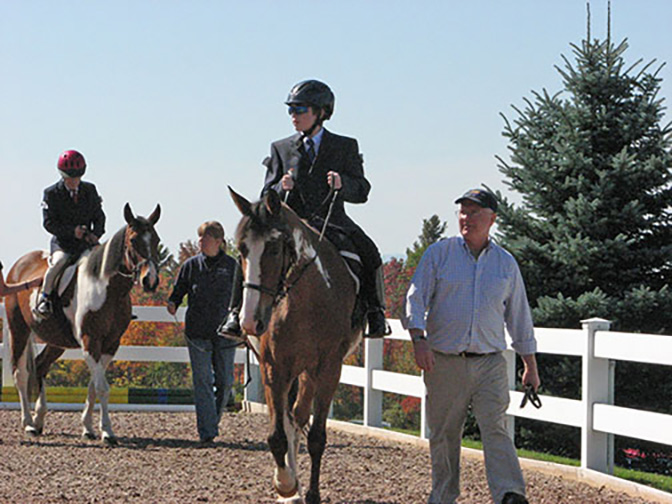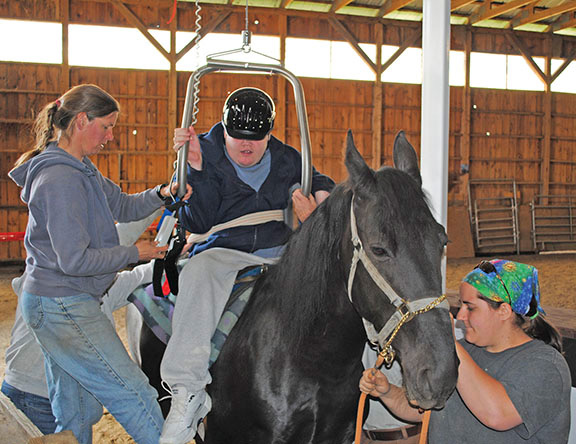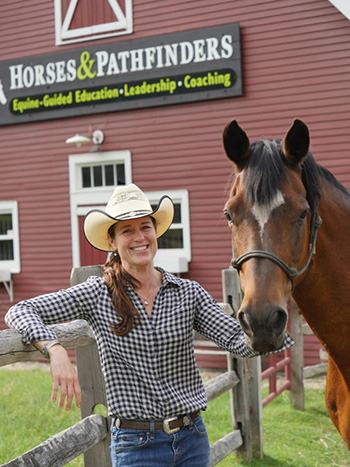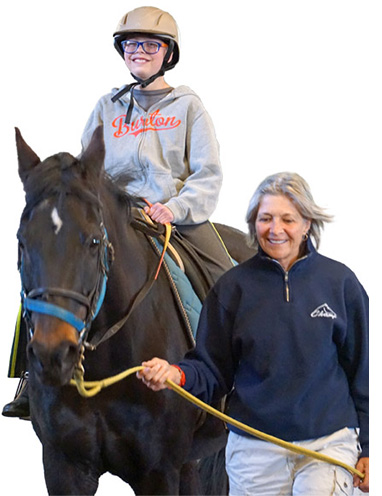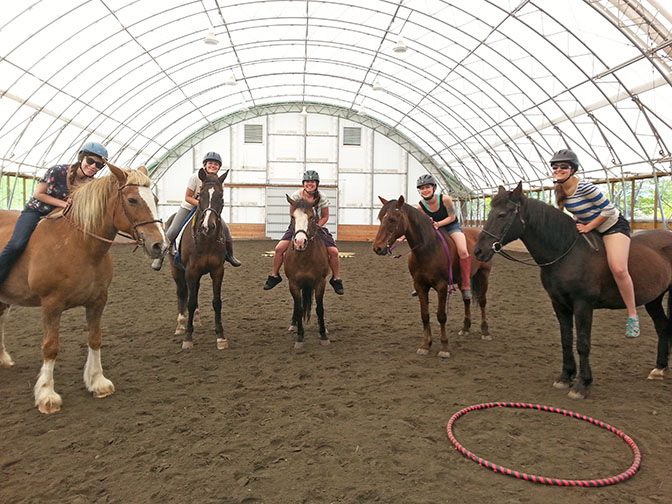| A Helping Hoof: The Horse as Guide and Therapist | ||||
| by Kate Mueller | ||||
For over 40 years, horses have been coming to the rescue, guiding and educating people—from physically challenged children to veterans with PTSD, teens with emotional problems, and adults seeking personal growth. The first use of horses for physical therapy dates back to 1969, when the North American Riding for the Handicapped Association (NARHA) was founded. In 1999, the Equine Assisted Growth and Learning Association was founded, expanding the role of horses beyond the physical. NARHA is now called the Professional Association of Therapeutic Horsemanship International (PATH); based in Colorado, PATH provides instructor certification, center accreditation, and educational opportunities. What is it about horses that makes them uniquely suited to this sort of work? The answers are several. Most obviously horses are large animals—and dealing with a 1,000-pound animal requires leadership skills that smaller therapy animals can’t provide. Because horses are herd and prey animals, they are highly attuned to each other, to other animals, and to their environment. Their senses are acute: with a 350-degree field of vision, they can see in front and almost all the way around their bodies; their mobile ears can take in sound information from multiple sources simultaneously. To survive in the wild, they have to work well as a group. Each horse has his or her “job,” and horse society is all about everyone working together harmoniously. As such, horses provide a model of how to be in the world, and they are also excellent mirrors. Sensitive as they are, they quickly pick up nonverbal cues from the humans near them and reflect what they are sensing. |
|
|||
Those are the more subtle psychological aspects of working with horses. But in other more prosaic ways, horses are well suited for both physical and emotional therapy. For a child or adult with mobility issues—whether disabled through an accident or because of a condition like cerebral palsy or multiple sclerosis—riding a horse offers the exhilarating opportunity of freedom of movement. For someone with emotional or psychological problems, learning to care for and ride a horse means developing a variety of skills and sensitivities that are bound to help the individual heal and grow: consideration for the horse, adapting to an individual horse’s way of being, learning to follow instructions, and learning to be a leader. Plus, just being around horses can have a calming and centering effect. Use of horses in education and therapy is a growing field. Currently in Vermont, there are about 10 places throughout the state (see sidebar) offering services ranging from equine-assisted coaching to hippotherapy—using horseback riding to improve coordination, balance, and strength (hippo is the Greek word for horse.) Dianne Lashoones, founder and director of Rhythm of the Rein Therapeutic Riding Center at Water Tower Farm, has been around horses nearly her entire life. “I rode my first horse at age 6,” says Lashoones, “and I was hooked.” While growing up, she had a quarter horse. But then came college and work, and for many years, horses ambled out of her life. Lashoones has a degree in physical therapy and for 34 years worked as a therapist in sports therapy, geriatrics, pediatrics, and adult special needs.
In 1988, Lashoones and her husband, Dick, decided to move to Vermont and bought the 70-acre Water Tower Farm, located just east of Marshfield. After years of not having horses, Lashoones now had the space to keep them and grabbed the opportunity. She got one—then another. But while riding one horse, the other, left alone in the stable, would “raise a ruckus.” The solution: another horse. After a fourth addition, it occurred to her to breed horses to support her horse habit, so she bought a stallion. Lashoones’s all-time favorite breed is the Tennessee walking horse. Lashoones and her husband began breeding these horses and through the ’90s ran a very successful horse-breeding operation, selling some two dozen walkers to Germany. Boarding, training, and riding lessons were also a large part of Water Tower Farm and continue to be to this day. Meanwhile, Lashoones continued to work as a physical therapist. In 2009, Lashoones’s home health supervisor encouraged her to work with some of their pediatric clients on horseback—and from that beginning the therapeutic riding program came to life. “Doing this combines the two sides of my life,” Lashoones notes—physical therapy and her love of horses. She is a PATH-certified therapeutic riding instructor, and Rhythm of the Rein is one of only four PATH premier accredited centers in the state. Being a therapy horse is both physically and mentally stressful, says Lashoones; it’s hard work carrying an unbalanced rider. “It’s like a person carrying an overactive toddler in a backpack, who keeps shifting around, making it difficult to walk,” she says. After the training, the horse is put to work but remains on probation for another two months. Two other PATH-certified instructors work part-time at the center, Libby Hale and Melissa DeLuke Falk. In addition, Hale is a licensed physical therapist and Falk a licensed occupational therapist. Otherwise, the center runs on volunteers. “We couldn’t do this without the volunteers,” says Lashoones. The center runs year-round and has about three dozen students. Lashoones works with a variety of populations, both children and adults: people with autism, cerebral palsy, multiple sclerosis, and genetic disorders; car accident and head trauma victims; and veterans with PTSD. |
||||
|
||||
Because the special needs population requires a lot of assistance, classes usually have just one or two students, with four being the maximum. During my visit I watched a lesson with 9-year-old Jordan mounted on Shiloh, a pretty chestnut mare with white markings. Her owner, Dick Chase, a volunteer at the center, assisted along with a second volunteer, Amy Hayes. Chase stood behind Shiloh, holding two long lead lines running on either side of the horse up to her bridle. Chase explained to me that if Jordan was unable to get Shiloh to stop or turn at a crucial moment, Chase could override and give the appropriate tug on his extra-long reins to direct the horse—kind of like a student-driver car with an extra brake for the instructor. Over the course of the hour-long lesson, Lashonnes put Jordan through his paces—with Chase bringing up the rear and Hayes trotting alongside—directing him to guide Shiloh around obstacles in the indoor arena, turning left and right, stopping and backing up the horse. As the director, Lashoones notes that she wears many hats, and one of them is raising funds for the operation. As a 501(3)c nonprofit, the center qualifies for grants, and she spends much of her time grant writing, she says. Local fundraising is also key. Lashoones says that originally Medicaid readily covered hippotherapy, but the guidelines for those that qualify have become stricter over the years. Currently only about three of her students receive these funds for therapy. To help those who can’t afford the therapy, the center engages in annual fundraising ventures to raise money for scholarships. The center’s eighth annual benefit ride will be held on October 2, 2016.
|
||||
|
Over in Moretown, Vermont, Lucinda Newman, founder and lead coach of Horses & Pathfinders, runs a very different equine-guided operation. Her program, founded in 2005, is aimed at individuals and groups who seek to expand leadership skills—for self-development, leading others, and being part of an effective team. It could be a group that needs to communicate and cooperate better or an individual seeking a new direction in life. Newman currently has four horses and boards a fifth on 10 acres, part of a former dairy farm located at the confluence of the Mad and Winooski Rivers. Newman attended the University of Vermont (UVM), getting her undergraduate degree in environmental studies with emphasis on nature writing. She went on to get a master’s degree in environmental law in policy and advocacy at Vermont Law School, inspired by Robert F. Kennedy Jr.’s example—his keen concern about the environment and fight to restore the Hudson River. Degrees in hand, Newman worked at the corporate level for Green Mountain Energy then consulted on program and funding development for the NGO sector, governmental agencies, educational institutions, and other businesses and was the executive director of the Composting Association of Vermont, founded in 2002, helping the organization get off the ground. |
|||
In 2001, Newman leased the property where her business is currently located. On the property stood an empty horse barn—the owner’s former wife had once kept horses. Newman’s landlord encouraged her to fill the empty stalls with horses, suggesting she find a couple of horses for him. In her search for horses, Newman volunteered for Hourse (Human Organization for Unraceable Standardbred Equines), in Jefferson, Vermont, run by C. Terry Holden. On her first visit, Holden asked Newman to do barn chores and groom the horses—and then left. A novice alone with a large herd of horses, Newman experienced something of an epiphany: “I never felt so home anywhere and had such a strong sense of belonging.” From Hourse, Newman brought back Poppe; a retired Amercan standardbred racehorse, he became her first equine guide. Newman also acquired a mare, who gave birth to a colt, Inra. This painted quarterhorse gelding with one blue “moon” eye is another member of her current stable of equine guides. She says she felt “very naturally comfortable around the horses because of my connection with animals and nature.” But because Newman didn’t have a background in horses— unlike Lashonnes she didn’t grow up with them—she notes that she was “a blank slate...open to what the horse was.” |
|
|||
Nate rides Currant, led by Pauline Gervais,
|
Bridging her decade-plus organizational development work and business coaching by way of horse and herd, Newman coaches and guides on leadership and team development with a variety of groups, ranging from small businesses, such as Vermont Artisan Coffee and Tea to major corporations, such as Blue Cross Blue Shield of Vermont, to nonprofits, such as High Horses Therapeutic Riding, in White River Junction, Vermont. This summer, 34 educators and staff from Mosaic Learning Center, in South Burlington, will be participating in leadership development at Horses & Pathfinders, her largest group yet. Learning with the horses is done on the ground, with various exercises with groups ranging in size from four to 24. Newman sometimes splits large groups into subgroups or “bands” as she calls them, much like what horses do naturally in the wild. So began a period of study and observation for Newman to learn more about what she was experiencing. Newman read about and attended trainings on natural horsemanship but after a time realized this wasn’t what she was looking for: it was too mechanical, emphasizing, she says, external tactics, tools, and strategies for training horses. She was after something deeper. |
|||
|
||||
VHAT has about 24 students who come for individual lessons, 16 students in afterschool programs, and another 16 in summer camp programs. Classes are kept small for safety and to maximize learning, usually no more than two at a time; the maximum is eight. “A lot of our kids are nonverbal and have severe mental and physical challenges,” Seidman notes. VHAT also works with adults, with one student well into her 70s. VHAT has two afterschool programs: the spring program is for special needs children and the fall one is for students with autism, each with eight students. What makes the programs unique is that each child is paired with a teenaged mentor. “We use teens at risk,” says Seidman, “teens who have their own challenges, as the aides in our programs. It’s a one-on-one pairing.” She says the teens are proud to help, and the work gives them a perspective on their own problems: they realize that others have it a lot worse. The program provides a community for the teens, both among themselves and with their young charges. Seidman is a PATH-certified instructor and a level 3 Centered Riding instructor. On her staff are Susan Mitchell, Becca Reggio, and Chrissy Rohan. Both Mitchell and Reggio are PATH certified, and Mitchell is also a certified Centered Riding instructor. Centered Riding, developed by the late Sally Swift, whom Seidman studied with in the mid-1990s, is based on body awareness and mechanics, says Seidman. “It’s getting in sync with the horse so that you are not obstructing your horse’s ability to do his work,” she says. She added that they use many concepts from the martial arts in riding: “We use centering and breathing, and we use a broad visual focus we call soft eyes.”
Seidman says that children who have been traumatized are often drawn to rescue horses. She notes that a rescue horse is not necessarily going to be sweet, friendly, and trusting. “When you match an apprehensive horse up with a kid, you can talk about why she’s looking at us worried and even angry,” says Seidman. “It’s because she’s been through something and she’s lost her trust, and the kid who is coming from that same situation can relate to that.” With an anxious horse, says Seidman, the rider still has to exhibit leadership to be safe and yet needs to be sensitive to the horse, who is not completely trusting for a reason. Synergistic healing resonating on many levels—a horse wounded by people is rescued by people and becomes the rescuer of wounded people. |
||||
|
Kate Mueller, editor of Vermont Woman newspaper, lives in Montpelier, Vermont.
|
|||
